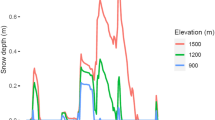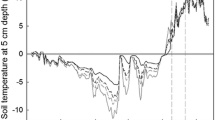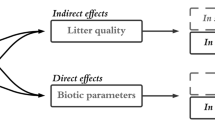Abstract
We assessed direct and indirect effects of snow cover on litter decomposition and litter nitrogen release in alpine tundra. Direct effects are driven by the direct influence of snow cover on edaphoclimatic conditions, whereas indirect effects result from the filtering effect of snow cover on species’ abundance and traits. We compared the in situ decomposition of leaf litter from four dominant plant species (two graminoids, two shrubs) at early and late snowmelt locations using a two-year litter-bag experiment. A seasonal experiment was also performed to estimate the relative importance of winter and summer decomposition. We found that growth form (graminoids vs. shrubs) are the main determinants of decomposition rate. Direct effect of snow cover exerted only a secondary influence. Whatever the species, early snowmelt locations showed consistently reduced decomposition rates and delayed final stages of N mineralization. This lower decomposition rate was associated with freezing soil temperatures during winter. The results suggest that a reduced snow cover may have a weak and immediate direct effect on litter decomposition rates and N availability in alpine tundra. A much larger impact on nutrient cycling is likely to be mediated by longer term changes in the relative abundance of lignin-rich dwarf shrubs.






Similar content being viewed by others
References
Baptist F, Choler P (2008) A simulation on the importance of growing season length and canopy functional properties on the seasonal Gross Primary Production of temperate alpine meadows. Ann Bot 101:549–559
Beniston M (2005) Mountain climates and climatic change: an overview of processes focusing on the European Alps. Pure Appl Geophys 162:1587–1606
Bleak AT (1970) Disappearance of plant material under winter snow cover. Ecology 51:915–917
Bosatta E, Agren GI (1999) Soil organic matter quality interpreted thermodynamically. Soil Biol Biochem 31:1889–1891
Brooks PD, McKnight D, Elder K (2004) Carbon limitation of soil respiration under winter snowpacks: potential feedbacks between growing season and winter carbon fluxes. Global Change Biol 11:231–238
Brooks PD, Schmidt SK, Williams MW (1997) Winter production of CO2 and N2O from alpine tundra: environmental controls and relationship to inter-system C and N fluxes. Oecologia 110:403–413
Bryant DM, Holland EA, Seastedt TR, Walker MD (1998) Analysis of litter decomposition in an alpine tundra. Can J Bot 76:1295–1304
Campbell JL, Mitchell MJ, Groffman PM, Christenson LM et al (2005) Winter in northeastern North America: a critical period for ecological processes. Front In Ecol Environ 3:314–322
Chimner RA, Welker JM (2005) Ecosystem respiration responses to experimental manipulations of winter and summer precipitation in a Mixedgrass Prairie, WY, USA. Biogeochemistry 73:257–270
Choler P (2005) Consistent shifts in alpine plant traits along a mesotopographical gradient. Arct Antarct Alp Res 37:444–453
Cornelissen JHC (1996) An experimental comparison of leaf decomposition rates in a wide range of temperate plant species and types. J Ecol 84:573–582
Cornelissen JHC, Perez Harguindeguy N, Diaz S, Grime JP et al (1999) Leaf structure and defence control litter decomposition rate across species and life forms in regional floras on two continents. New Phytol 143:191–200
Cornelissen JHC, Lavorel S, Garnier E, Diaz S et al (2003) A handbook of protocols for standardised and easy measurement of plant functional traits worldwide. Aust J Bot 51:335–380
Cornelissen JHC, van Bodegom PM, Aerts R, Callaghan TV et al (2007) Global negative vegetation feedback to climate warming responses of leaf litter decomposition rates in cold biomes. Ecol Lett 10:619–627
Duchaufour P, Gilot J-C (1966) Etude d’une chaîne de sols de l’étage alpin (col du Galibier) et ses relations avec la végétation. Oecol Plant 1:253–274
Edwards AC, Scalenghe R, Freppaz M (2007) Changes in the seasonal snow cover of alpine regions and its effect on soil processes: a review. Quaternary Int 172:162–163
Ellis GH, Matrone G, Maynard LA (1946) A 72-percent H2SO4 method for the determination of lignin and its use in animal nutrition studies. J Anim Sci 5:285–297
Fahnestock JT, Jones MH, Welker JM (1999) Wintertime CO2 efflux from arctic soils: implications for annual carbon budgets. Global Biogeochem Cy 13:775–779
Fisk MC, Schmidt SK, Seastedt TR (1998) Topographic patterns of above- and belowground production and nitrogen cycling in Alpine tundra. Ecology 79:2253–2266
Groffman PM, Driscoll CT, Fahey TJ, Hardy JP et al (2001) Effects of mild winter freezing on soil nitrogen and carbon dynamics in a northern hardwood forest. Biogeochemistry 56:191–213
Hobbie SE (1996) Temperature and plant species control over litter decomposition in Alaskan tundra. Ecol Monogr 66:269–279
Hobbie SE, Chapin FS (1996) Winter regulation of tundra litter carbon and nitrogen dynamics. Biogeochemistry 35:327–338
Hobbie SE, Gough L (2004) Litter decomposition in moist acidic and non-acidic tundra with different glacial histories. Oecologia 140:113–124
Kazakou E, Vile D, Shipley B, Gallet C et al (2006) Co-variations in litter decomposition, leaf traits and plant growth in species from a Mediterranean old-field succession. Funct Ecol 20:21–30
Körner C (1999) Alpine plant life. Springer Verlag, Berlin, 338 p
Kudo G (1996) Intraspecific variation of leaf traits in several deciduous species in relation to lenght of growing season. Ecoscience 3:483–489
Kudo G, Ito K (1992) Plant distribution in relation to the lenght of the growing season in a snow-bed in the Taisetsu mountains, northern Japan. Vegetatio 98:319–328
Kudo G, Molau U, Wada N (2001) Leaf-trait variation of tundra plants along a climatic gradient: an integration of responses in evergreen and deciduous species. Arct Antarct Alp Res 33:181–190
Kueppers LM, Harte J (2005) Subalpine forest carbon cycling: short- and long-term influence of climate and species. Ecol Appl 15:1984–1999
Lipson DA, Schmidt SK, Monson RK (1999) Links between microbial population dynamics and nitrogen availability in an alpine ecosystem. Ecology 80:1623–1631
Meentemeyer V (1978) Macroclimate and lignin control over litter decomposition rates. Ecology 59:465–472
Melillo J, Aber J, Muratore J (1982) Nitrogen and lignin control of hardwood leaf litter decomposition dynamics. Ecology 63:571–584
Monson RK, Lipson DL, Burns SP, Turnipseed AA et al (2006) Winter forest soil respiration controlled by climate and microbial community composition. Nature 439:711–714
Nadelhoffer KJ, Giblin AE, Shaver GR, Laundre JA (1991) Effects of temperature and substrate quality on element mineralization in six arctic soils. Ecology 72:75–86
Nyman T, Julkunen Tiitto R (2005) Chemical variation within and among six northern willow species. Phytochemistry 66:2836–2843
O’Lear HA, Seastedt TR (1994) Landscape patterns of litter decomposition in alpine tundra. Oecologia 99:95–101
Oechel WC, Vourlitis G, Hastings SJ (1997) Cold season CO2 emission from arctic soils. Global Biogeochem Cy 11:163–172
Parton W, Silver WL, Burke IC, Grassens L et al (2007) Global-scale similarities in nitrogen release patterns during long-term decomposition. Science 315:361–364
Perez Harguindeguy N, Diaz S, Cornelissen JHC, Vendramini F et al (2000) Chemistry and toughness predict leaf litter decomposition rates over a wide spectrum of functional types and taxa in central Argentina. Plant Soil 218:21–30
Pinheiro JC, Bates DM (2000) Mixed-effects models in S and S-Plus. Springer, New York, 528 p
Pinheiro JC, Bates D, DebRoy S, Deepayan S (2007) nlme: linear and nonlinear mixed effects models. R package version 3.1–86
Quétier F, Thebault A, Lavorel S (2007) Plant traits in a state and transition framework as markers of ecosystem response to land-use change. Ecol Mono 77:33–52
R Development Core Team (2007) R: a language and environment for statistical computing. R Foundation for Statistical Computing, Vienna, Austria
Robinson CH (2002) Controls on decomposition and soil nitrogen availability at high latitudes. Plant Soil 242:65–81
Rustad LE (2006) From transient to steady-state response of ecosystems to atmospheric CO2-enrichment and global climate change: conceptual challenges and need for an integrated approach. Plant Ecol 182:43–62
Schmidt SK, Lipson DA (2004) Microbial growth under the snow: implications for nutrient and allelochemical availability in temperate soils. Plant Soil 259:1–7
Serreze MC, Walsh JE, Chapin FS, Osterkamp T et al (2000) Observational evidence of recent change in the northern high-latitude environment. Clim Change 46:159–207
Steltzer H, Bowman WD (2005) Litter N retention over winter for a low and a high phenolic species in the alpine tundra. Plant Soil 275:361–370
Sturm M, Racine C, Tape K (2001) Climate change—increasing shrub abundance in the Arctic. Nature 411:546–547
Theurillat JP, Guisan A (2001) Potential impact of climate change on vegetation in the European Alps: a review. Clim Change 50:77–109
Uchida M, Mo W, Nakatsubo T, Tsuchiya Y et al (2005) Microbial activity and litter decomposition under snow cover in a cool-temperate broad-leaved deciduous forest. Agr Forest Meteorol 134:102–109
Walker DA, Halfpenny JC, Walker MD, Wessman CA (1993) Long-term studies of snow-vegetation interactions. Bioscience 43:471–480
Walker MD, Walker DA, Welker JM, Arft AM et al (1999) Long-term experimental manipulation of winter snow regime and summer temperature in arctic and alpine tundra. Hydrol Process 13:2315–2330
Walker MD, Wahren CH, Hollister RD, Henry GHR et al (2006) From the cover: plant community responses to experimental warming across the tundra biome. P Natl Acad Sci USA 103:1342–1346
Welker JM, Fahnestock JT, Jones MH (2000) Annual CO2 flux in dry and moist arctic tundra: field responses to increases in summer temperatures and winter snow depth. Clim Change 44:139–150
Wilson SD, Nilsson C (2009) Arctic alpine vegetation change over 20 years. Global Change Biol 15:1676–1684
Zimov SA, Davidov SP, Zimova GM, Davidova AI et al (1999) Contribution of disturbance to increasing seasonal amplitude of atmospheric CO2. Science 284:1973–1976
Acknowledgements
We are grateful to Serge Aubert and to Céline Flahaut, Geneviève Girard, Cécile Bayle, Marie-Pascale Colace and Mathieu Chausson for their help in the field and in the laboratory. We gratefully thank Natalia Pérez Harguindeguy, Fabien Quétier, Matthew Robson, Mason Campbell and two anonymous reviewers for their helpful comments on an earlier version of this manuscript. Logistical support was provided by the Station Alpine Joseph Fourier, the alpine field station of the University Joseph Fourier. The work was funded by the ANR-06-BLAN-0301 “Microalpes” project.
Author information
Authors and Affiliations
Corresponding author
Additional information
Responsible Editor: Hans Lambers.
Electronic supplementary material
Below is the link to the electronic supplementary material.
Table S1
Statistics and decay constants (k) from regression of litter mass remaining against time in years. Regressions were done for each species and snowmelt location separately (Experiment I). Values are the mean (se). (DOC 49 kb)
Fig. S1
Localization of the study sites in the mountain ranges of Grand Galibier and Grandes Rousses, South-Western French Alps (45°7′N, 6°5′E) and arrangement of the litter bags in early and late snowmelt locations in experiment I and II.
Fig. S2
Mass loss of standard litter set up in 2003 against mass loss of standard litter set up in 2004 (Experiment I). Each point corresponds to the mean of eight replicates ± se from one site and one year. Short dash line: linear regression to data, dotted line: linear regression when slope is forced to one, solid line 1:1 slope.
The slope of the relationship between the remaining biomass of SLII and SLI was not significantly different from one (slope = 0.85 ± 0.09, confidence intervals = [0.65, 1.04]), whereas the intercept was different from zero (intercept = 10.98 ± 4.75, t 1,11 = 2.31, P = 0.04). This indicates that decomposition was higher during the 2004–2006 than during 2003–2005. However, after constraining the slope to a value of 1, the intercept was greatly reduced (intercept: 2.65 ± 0.92, t 1,11 = 2.87 P = 0.01) and ranged from 0.62% to 4.67% of mass loss.
Fig. S3
Raw data of litter mass loss after one and two years in the sites A, B and C in early (black) and late (white) snowmelt locations for Salix herbacea (a–b, year I and II respectively), Dryas octopetala (c–d, year I and II respectively), Carex foetida (e–f, year I and II respectively) and Kobresia myosuroides (g–h, year I and II respectively, Experiment I).
Rights and permissions
About this article
Cite this article
Baptist, F., Yoccoz, N.G. & Choler, P. Direct and indirect control by snow cover over decomposition in alpine tundra along a snowmelt gradient. Plant Soil 328, 397–410 (2010). https://doi.org/10.1007/s11104-009-0119-6
Received:
Accepted:
Published:
Issue Date:
DOI: https://doi.org/10.1007/s11104-009-0119-6




